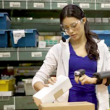

In the past, warehouse workers, otherwise known as pickers, would worth with lists and manually run a warehouse. This took pickers a long time to get shipments in order just and this laborious practice soon became outdated when digital advanced, writes Suzanne Vallance, who works for Ferrari Packaging, a wholesale packaging supplies company based in Scotland.
IoE practices in warehouses
Warehouses have started to use the Internet of Everything (IoE), robotic systems which makes the working day much more effective. IoE and voice picking have improved the efficiency of warehouse practices. Sensors can now even detect everything through a robotic system and businesses can check where their pallets are, whether that is in the warehouse or en route to the shipping dock.
Progressively, businesses are adapting to IoE technology and are connecting the different departments in their organisation. These warehouses, like new technology that we use every day, are called “smart warehouses” and have increased productivity across the board.
IoT and cloud software for business
Cloud software is continuing to develop and change security perceptions. Steve Banker from Forbes Online has stated that there are benefits of using IoT in warehouses and has highlighted how pickers are management are adjusting to the change: “Most well run warehouses have a Warehouse Management Systems (WMS) that depends upon bar code data. Warehouse floor level operations personnel and warehouse managers execute their tasks based upon this data.”
This is true, figures from 2015 have shown the growth of IoT in business, especially in the use of cloud technology:
Cloud software is hosted elsewhere, virtually and businesses manage their accounts by accessing the software over the internet. Organisations will be charged a cloud fee, however, this includes hosting services.
What is a voice picking cloud?
The main method of internet picking is through a voice picking cloud solution. This means organisations can host their information remotely.
This is beneficial as it means your business does not have to obtain, install or maintain servers. This will not only improve staff efficiency in the long run but it will cut costs. In-house IT hardware can be problematic when it comes to continual security and maintenance.
Argos is just one of the UK’s multichannel retailers that have moved away from paper trail picking. This has been beneficial to the company as they claim it has boosted staff productivity and accuracy.
Getting it right the first time is now more important than ever as the fast delivery pressure from the “Amazon effect” is hitting the retail business. Thankfully for Argos, its level of accuracy is going up and accuracy error rates have decreased from just over 1% to less than 0.3%.
By adopting a voice picking system a business will become more consistent. The paper trail has become outdated, therefore it may be worth businesses looking into business improvement across the board, especially in the operational side of businesses.
Operational vs technical in the warehouse
Remember, improving the technological side of your business is vital, but maintaining the operations section of it, is just as important.
Adopting cloud technology will allow for reduced operational costs, but it’s good practice not to reply on the cloud alone to protect your goods. Amazon uses the cloud to help protect against theft, by using a system that updates every thirty minutes, however for the SME traditional methods for protecting your stored items should not be disregarded. Invest in suitable packaging supplies that will act as a secondary dimension of protection for your goods.
IoT warehouse operations
Changing your business ethic can be risky, therefore it always worth trialling different methods of IoT. By using the internet to enhance your workplace it will not only encourage your employees to work harder but they will learn new, digital skills. The beauty of the internet is that is growing and it is never too late to change, you could see the benefits of IoT in your warehouse works in a matter of months.
July 27, 2016
Posted by: George Malim

It has been predicted that an incredible six billion people will have a smartphone by 2020. In our pocket, we possess a supercomputer, millions of times more powerful than all of NASA’s combined computing capability during the Apollo space missions, writes Simon Skellon, the vice president of sales at Mitel. (more…)
July 25, 2016
Posted by: George Malim

The World Cities Summit in Singapore explored how cities can better govern and build up resilience through policy, technology and social innovations. City leaders and planners sought to look for ways to create and integrate innovative urban solutions for a more sustainable future, writes Nigel Chadwick, the managing director for EuroNorth at Dassault Systèmes. (more…)
July 22, 2016
Posted by: George Malim

The internet of things (IoT) is introducing itself into every industry and revolutionising the lives of consumers and businesses alike, writes Paul Burke, the vice president of management for cloud and applications at Oncam. (more…)
July 21, 2016
Posted by: George Malim

IoT devices are often built to strive for efficiency. If you remove the huge, power hungry screen of a mobile phone the energy consumption will naturally be lower, write Abilio Marques, a senior software engineer, and Bettina Rubek Slater, the chief operating and chief marketing officer of Pycom, in the second part of their blog. (more…)
Posted by: George Malim

As we well know, world leaders are working on managing climate change and are negotiating hard to forge treaties that reduce carbon emissions. However, as the IoT revolution kicks in the effort going into protecting the planet, may actually be counter productive if we need more energy to drive the connected living we aspire to, write Abilio Marques, a senior software engineer, and Bettina Rubek Slater, the chief operating and chief marketing officer of Pycom. (more…)
July 20, 2016
Posted by: George Malim

Infosec pros have spent the past decade fighting a rising tide of both more users and more devices connecting to enterprise resources while at the same time trying to decrease the attack surface — that is, trying to shut down as many points of access as possible, writes Joe Schorr is director of advanced security solutions at Bomgar. (more…)
July 18, 2016
Posted by: George Malim

2015 brought with it much conversation around the Internet of Things, writes Brian Foster the senior vice president of information services at Neustar. The mainstream conversation around mass connectivity developed from being a personal fad to a genuinely credible approach to effective business management – but for many the idea of IoT for the enterprise is old hat. (more…)
Posted by: George Malim

In the second part of his blog, Neil Oliver, the technical marketing manager at Accutronics, continues to examine how IoT advances are impacting the health and healthcare of users. (more…)
July 15, 2016
Posted by: George Malim

Sales of smartphones hit record highs in 2014 and the market continues to grow rapidly. Many have attributed this to the use of health and fitness monitoring apps by both consumers and patients, writes Neil Oliver, the technical marketing manager at Accutronics in the first part of his blog. (more…)
July 14, 2016
Posted by: George Malim